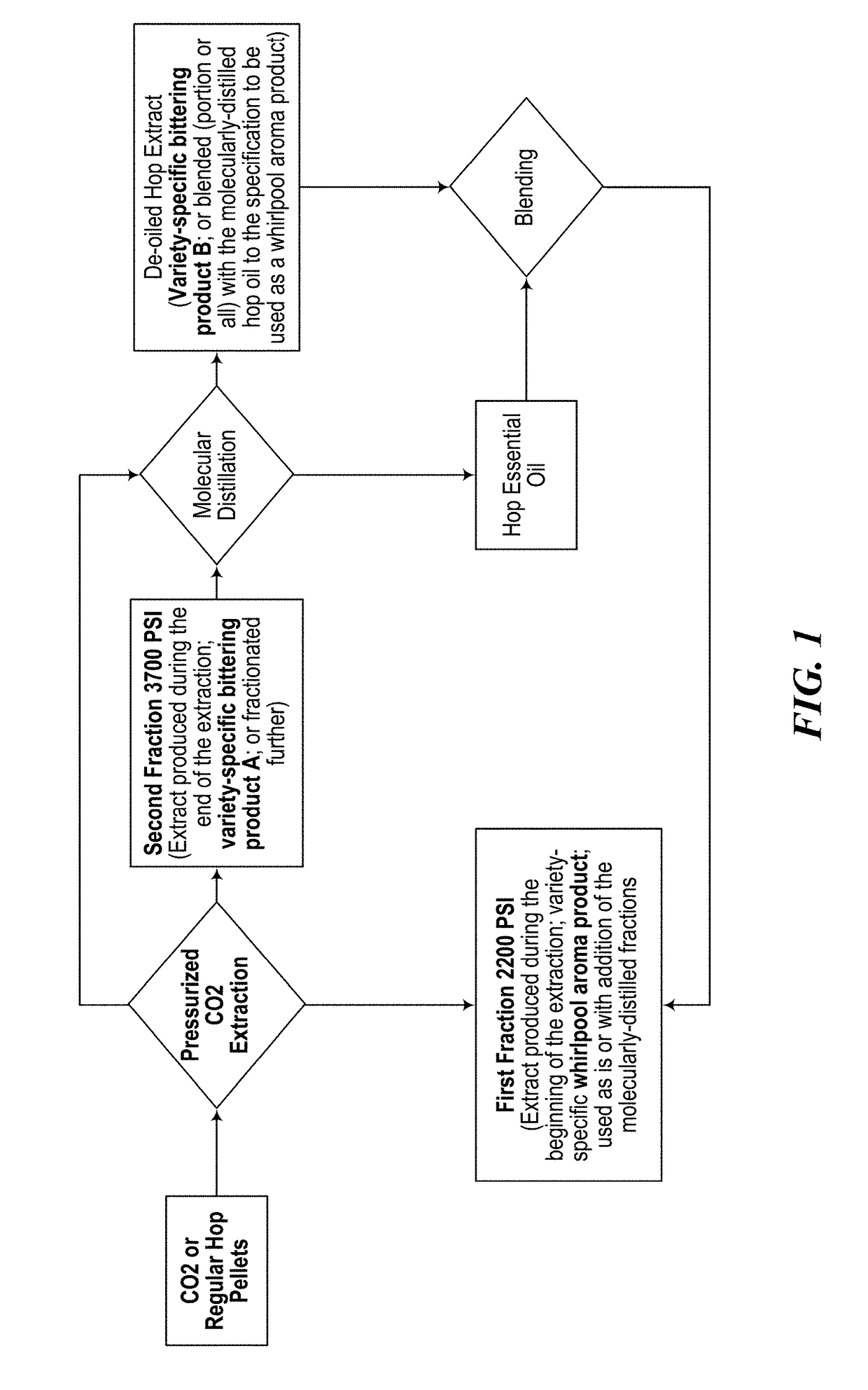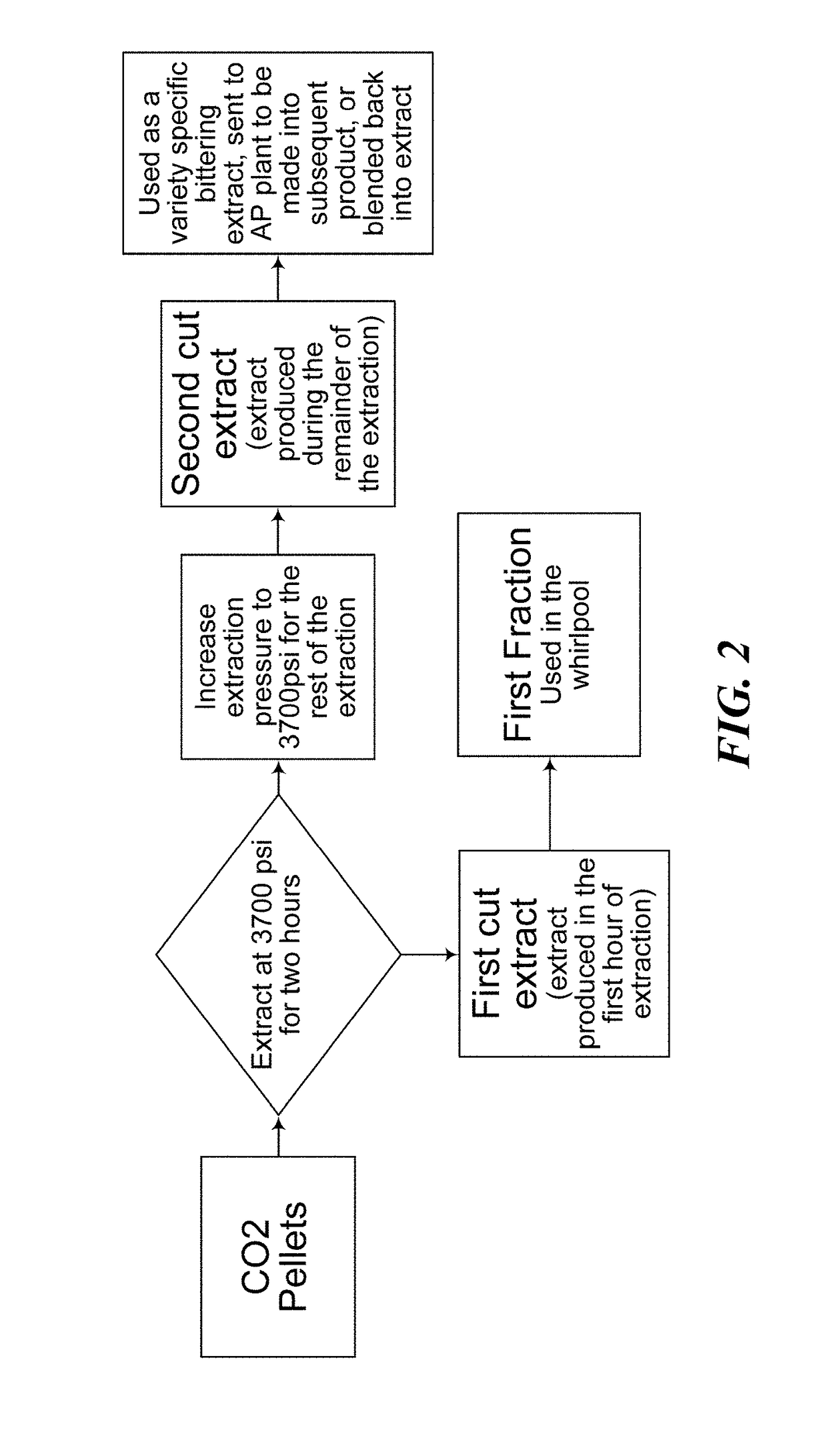Hop extraction products and processes for improved beverage fermentation and flavor
a technology of extraction products and extraction processes, which is applied in the field of new co2 oil enriched hop extract products, can solve the problems of reducing aroma and flavoring characteristics, unable to be found in finished beer, and volatile hop oils in the brew kettle boil, etc., and achieves the effect of maximizing the potential contribution of whole hop additions at different points in the brewing process
- Summary
- Abstract
- Description
- Claims
- Application Information
AI Technical Summary
Benefits of technology
Problems solved by technology
Method used
Image
Examples
example 1
Sensory Outcomes of CO2 Hop Extract Vs. Enriched Oil First Extract Products, of the Present Invention
[0123]Introduction:
[0124]The presented trials explore the comparisons of using four different CITRA supercritical CO2 hop extracts made under varying pressures and extraction parameters as a means of delivering efficient flavor and aroma in beer. These trials are summarized in Tables 5 and 6. Historically, brewers have used supercritical CO2 hop extracts as an early beginning of boil (typically 60-90 minute boils) kettle bittering addition, due to their high 35->50% alpha acid concentrations depending on hop variety. More recently, as brewers have become more conscious of yield savings and hot-side efficiencies out of the kettle, supercritical CO2 hop extracts have been explored at later addition points late in the boil process in the kettle and whirlpool in effort to achieve optimal flavor and aroma without losing wort volumes due to vegetative liquid absorption presently seen in ho...
example 2
Sensory of CITRA Pellets Vs. CITRA Enriched Oil Hop Extract in Whirlpool
[0138]Introduction:
[0139]The presented trials look at sensory comparisons of CITRA Pellets to CITRA enriched oil hop extract when used in the whirlpool when comparing on the basis of alpha acids content. Additionally, this study further compares sensory analyses of CITRA enriched oil hop extract whirlpool and dry-hopped pellet beer. The overarching goal of these comparisons is to better understand what enriched oil hop extract can potentially offer a brewer who uses this product over hop pellets.
[0140]Materials and Methods:
[0141]Three separate 230 L trial beers were brewed at the Haas Innovations Brewery to target 40 IBU at 12° P. For each, the CITRA Pellets, the CITRA Pellets and Dry Hop, and CITRA enriched oil hop extract were added to the whirlpool at the end of boil for a 60 minute residency time prior to fermentation. Each beer was fermented with Wyeast 1056 Ale Yeast under 65° F. fermentation conditions. T...
example 3
OHAI Sensory of CITRA Pellets Vs. CITRA Enriched Oil Hop Extract
[0147]Introduction:
[0148]The presented trials look at sensory comparisons of beer made using CITRA Pellets to CITRA enriched oil hop extract when used in the whirlpool and when comparing on the basis of alpha acids content. Additionally, this study further compares Overall Hop Aroma Intensity sensory of CITRA enriched oil hop extract to a CITRA pellet beer. Subsequently, these beers were dry hopped at varying rates in order to determine the flavor and aromatic impact of a beer that uses Enriched oil hop extract versus that of pellets. The overarching goal of these comparisons is to better understand what enriched oil hop extract can potentially offer a brewer who uses this product over hop pellets.
[0149]Materials and Methods:
[0150]Two separate 230 L trial beers comprising of 97% pale malted barley and 3% acidulated malt were brewed to target 40 IBU at 12° P. For each, the CITRA Pellets and CITRA enriched oil hop extract...
PUM
| Property | Measurement | Unit |
|---|---|---|
| temperature | aaaaa | aaaaa |
| pressure | aaaaa | aaaaa |
| temperatures | aaaaa | aaaaa |
Abstract
Description
Claims
Application Information
 Login to View More
Login to View More - R&D
- Intellectual Property
- Life Sciences
- Materials
- Tech Scout
- Unparalleled Data Quality
- Higher Quality Content
- 60% Fewer Hallucinations
Browse by: Latest US Patents, China's latest patents, Technical Efficacy Thesaurus, Application Domain, Technology Topic, Popular Technical Reports.
© 2025 PatSnap. All rights reserved.Legal|Privacy policy|Modern Slavery Act Transparency Statement|Sitemap|About US| Contact US: help@patsnap.com



